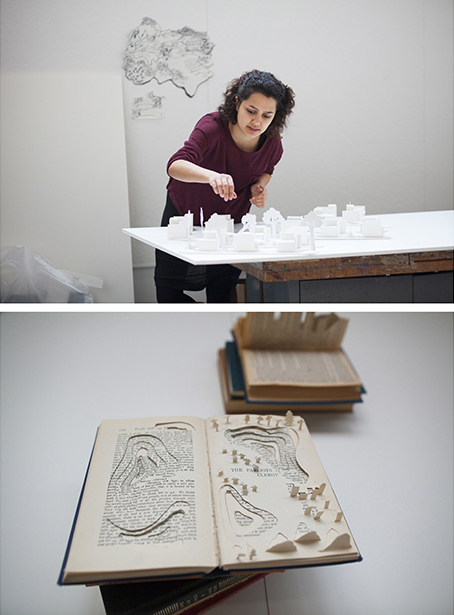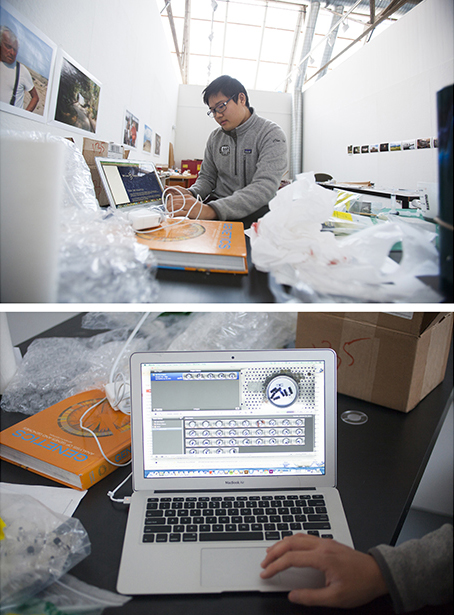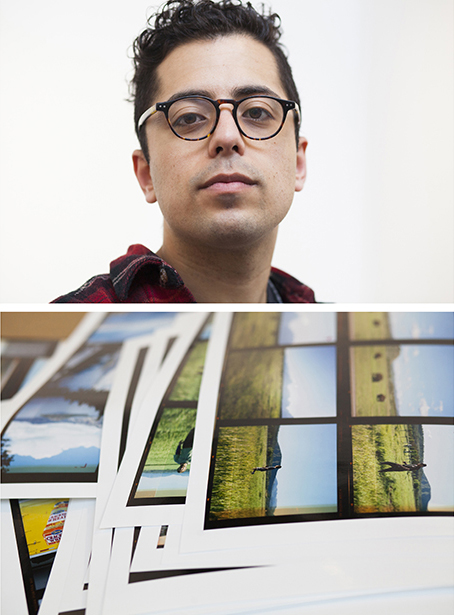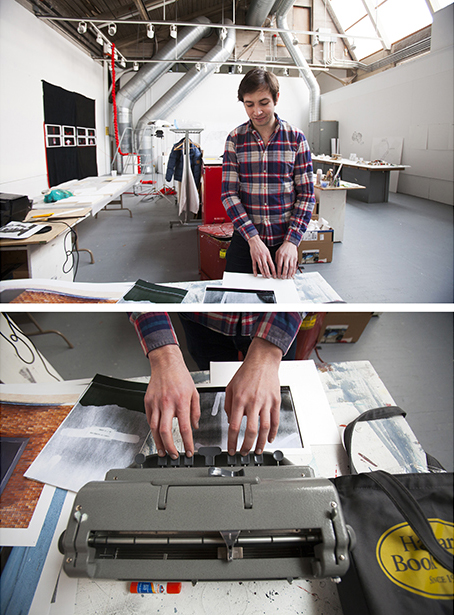HIDDEN IN PLAIN SIGHT

VES thesis students dive deep in the Linden Street studios
Utopian worlds, sign-language poetry, and DNA origami — the subjects are as fascinating and varied as the students who explore them.
Along a small street in the heart of Harvard Square, Visual and Environmental Studies (VES) students are busy at work on their thesis projects in the Linden Street studios.
Converted from squash courts in 1999, the centrally located spot offers students generously open and well-lit spaces, 24-hour access, and studios shared with fellow students to inspire, collaborate, and critique their creations.
“It’s nice to have a space with the other thesis students as a community, a place to come together,” said Brooke Griffin. To her, the studios show that Harvard recognizes the importance of VES and its thesis students.
“I love VES. It’s almost like which part of that love to talk about,” said Zena Mengesha. “It’s really incredible to be able to dive into visual studies in the way VES sets it out. Human beings are such visually dependent creatures. And the attention that we pay to studying the visual world is relatively small … I don’t know if everybody thinks of art as an academically rigorous program, but it can be.”

︎︎
VES concentrators in studio art, film, video, and animation propose their thesis projects in the spring of their junior year, enroll in the program in the fall of their senior year, and work throughout the year to complete their projects. Just more than 70 percent of VES concentrators do a senior thesis. Starting on May 2, an exhibit of their final work will be on display in the Carpenter Center.
“It’s unique to get space, and such great space,” said Manager of Academic Programs for VES Paula Soares. “It’s a privilege, and it’s something that a lot of schools cannot give their undergraduates. But it’s not just the space, it’s the resources, the one-on-one attention. The experience is rich in a lot of ways.”
“This is truly a phenomenal resource to have. I will never have a studio space this nice in my life,” said Ethan Pierce. “Having access to these resources and materials as well as to the thesis budget really allows for an opportunity of exploration sans stress that is truly unique.”
“It’s unique to get space, and such great space,” said Manager of Academic Programs for VES Paula Soares. “It’s a privilege, and it’s something that a lot of schools cannot give their undergraduates. But it’s not just the space, it’s the resources, the one-on-one attention. The experience is rich in a lot of ways.”
“This is truly a phenomenal resource to have. I will never have a studio space this nice in my life,” said Ethan Pierce. “Having access to these resources and materials as well as to the thesis budget really allows for an opportunity of exploration sans stress that is truly unique.”



Tony Cho investigates synthetic biology for this thesis project, “mainly two fields within that, microfluidics and self-assembly.” He makes interdisciplinary work with laser-cut acrylic that combines his interests in biology and the arts.
Tony takes principles from DNA origami and brings them to the macro scale. He creates a video animation with tiles that move over a mixer. They hit each other randomly, and if the sequences on the side are complementary, they stay together; if not, they fall apart.
Tony takes principles from DNA origami and brings them to the macro scale. He creates a video animation with tiles that move over a mixer. They hit each other randomly, and if the sequences on the side are complementary, they stay together; if not, they fall apart.
Matthew Plaks photographs communities around the country and tries to unravel what it means to be inside and outside a community. His images focus on “exclusion and solitude.”
In less than three months, Matthew Plaks traveled across 21 states, through large cities and small towns as a wandering photographer, engaging with communities, and, at times, staying in the homes of strangers.
In less than three months, Matthew Plaks traveled across 21 states, through large cities and small towns as a wandering photographer, engaging with communities, and, at times, staying in the homes of strangers.
“My thesis project is a pop-up gallery called the BBP gallery, which stands for Baby Boy Pierce, which is my real name,” said Ethan Pierce. “It serves as a platform for an alternative artistic discourse.”
“The gallery is a black metal sculptural object that used to have a life as a bookshelf that I wheel around on a red dolly,” said Ethan Pierce. “And I’m interested in the way it functions socially as I’m wheeling it through the streets of Cambridge and Boston, as well as architecturally in these spaces. But more importantly it’s the platform that it creates for interactions.”
“The gallery is a black metal sculptural object that used to have a life as a bookshelf that I wheel around on a red dolly,” said Ethan Pierce. “And I’m interested in the way it functions socially as I’m wheeling it through the streets of Cambridge and Boston, as well as architecturally in these spaces. But more importantly it’s the platform that it creates for interactions.”